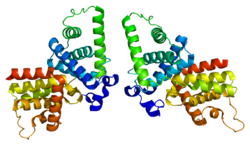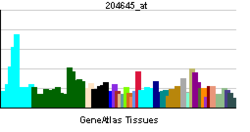- Cyclin T2
-
Cyclin-T2 is a protein that in humans is encoded by the CCNT2 gene.[1][2][3]
The protein encoded by this gene belongs to the highly conserved cyclin family, whose members are characterized by a dramatic periodicity in protein abundance through the cell cycle. Cyclins function as regulators of CDK kinases. Different cyclins exhibit distinct expression and degradation patterns which contribute to the temporal coordination of each mitotic event. This cyclin and its kinase partner CDK9 were found to be subunits of the transcription elongation factor p-TEFb. The p-TEFb complex containing this cyclin was reported to interact with, and act as a negative regulator of human immunodeficiency virus type 1 (HIV-1) Tat protein. Two alternatively spliced transcript variants, which encode distinct isoforms, have been described.[3]
Contents
Interactions
Cyclin T2 has been shown to interact with CDK9[1] and Retinoblastoma protein.[4]
References
- ^ a b Peng J, Zhu Y, Milton JT, Price DH (Apr 1998). "Identification of multiple cyclin subunits of human P-TEFb". Genes Dev 12 (5): 755–62. doi:10.1101/gad.12.5.755. PMC 316581. PMID 9499409. http://www.pubmedcentral.nih.gov/articlerender.fcgi?tool=pmcentrez&artid=316581.
- ^ Napolitano G, Licciardo P, Gallo P, Majello B, Giordano A, Lania L (Nov 1999). "The CDK9-associated cyclins T1 and T2 exert opposite effects on HIV-1 Tat activity". AIDS 13 (12): 1453–9. doi:10.1097/00002030-199908200-00003. PMID 10465067.
- ^ a b "Entrez Gene: CCNT2 cyclin T2". http://www.ncbi.nlm.nih.gov/sites/entrez?Db=gene&Cmd=ShowDetailView&TermToSearch=905.
- ^ Simone, Cristiano; Bagella Luigi, Bellan Cristiana, Giordano Antonio (Jun. 2002). "Physical interaction between pRb and cdk9/cyclinT2 complex". Oncogene (England) 21 (26): 4158–65. doi:10.1038/sj.onc.1205511. ISSN 0950-9232. PMID 12037672.
Further reading
- Wolff A (1976). "[Problem of occupational disability hazards]". Lebensversicherungs Medizin 28 (3): 76–7. PMID 9544.
- Wimmer J, Fujinaga K, Taube R, et al. (1999). "Interactions between Tat and TAR and human immunodeficiency virus replication are facilitated by human cyclin T1 but not cyclins T2a or T2b.". Virology 255 (1): 182–9. doi:10.1006/viro.1998.9589. PMID 10049833.
- Kwak YT, Ivanov D, Guo J, et al. (1999). "Role of the human and murine cyclin T proteins in regulating HIV-1 tat-activation.". J. Mol. Biol. 288 (1): 57–69. doi:10.1006/jmbi.1999.2664. PMID 10329126.
- Bieniasz PD, Grdina TA, Bogerd HP, Cullen BR (1999). "Analysis of the effect of natural sequence variation in Tat and in cyclin T on the formation and RNA binding properties of Tat-cyclin T complexes.". J. Virol. 73 (7): 5777–86. PMC 112638. PMID 10364329. http://www.pubmedcentral.nih.gov/articlerender.fcgi?tool=pmcentrez&artid=112638.
- Herrmann CH, Mancini MA (2001). "The Cdk9 and cyclin T subunits of TAK/P-TEFb localize to splicing factor-rich nuclear speckle regions.". J. Cell. Sci. 114 (Pt 8): 1491–503. PMID 11282025.
- Nguyen VT, Kiss T, Michels AA, Bensaude O (2001). "7SK small nuclear RNA binds to and inhibits the activity of CDK9/cyclin T complexes.". Nature 414 (6861): 322–5. doi:10.1038/35104581. PMID 11713533.
- Tolstonog GV, Mothes E, Shoeman RL, Traub P (2002). "Isolation of SDS-stable complexes of the intermediate filament protein vimentin with repetitive, mobile, nuclear matrix attachment region, and mitochondrial DNA sequence elements from cultured mouse and human fibroblasts.". DNA Cell Biol. 20 (9): 531–54. doi:10.1089/104454901317094954. PMID 11747605.
- Simone C, Bagella L, Bellan C, Giordano A (2002). "Physical interaction between pRb and cdk9/cyclinT2 complex.". Oncogene 21 (26): 4158–65. doi:10.1038/sj.onc.1205511. PMID 12037672.
- Strausberg RL, Feingold EA, Grouse LH, et al. (2003). "Generation and initial analysis of more than 15,000 full-length human and mouse cDNA sequences.". Proc. Natl. Acad. Sci. U.S.A. 99 (26): 16899–903. doi:10.1073/pnas.242603899. PMC 139241. PMID 12477932. http://www.pubmedcentral.nih.gov/articlerender.fcgi?tool=pmcentrez&artid=139241.
- Michels AA, Nguyen VT, Fraldi A, et al. (2003). "MAQ1 and 7SK RNA interact with CDK9/cyclin T complexes in a transcription-dependent manner.". Mol. Cell. Biol. 23 (14): 4859–69. doi:10.1128/MCB.23.14.4859-4869.2003. PMC 162212. PMID 12832472. http://www.pubmedcentral.nih.gov/articlerender.fcgi?tool=pmcentrez&artid=162212.
- Beausoleil SA, Jedrychowski M, Schwartz D, et al. (2004). "Large-scale characterization of HeLa cell nuclear phosphoproteins.". Proc. Natl. Acad. Sci. U.S.A. 101 (33): 12130–5. doi:10.1073/pnas.0404720101. PMC 514446. PMID 15302935. http://www.pubmedcentral.nih.gov/articlerender.fcgi?tool=pmcentrez&artid=514446.
- Kurosu T, Zhang F, Peterlin BM (2005). "Transcriptional activity and substrate recognition of cyclin T2 from P-TEFb.". Gene 343 (1): 173–9. doi:10.1016/j.gene.2004.08.027. PMID 15563843.
- Hillier LW, Graves TA, Fulton RS, et al. (2005). "Generation and annotation of the DNA sequences of human chromosomes 2 and 4.". Nature 434 (7034): 724–31. doi:10.1038/nature03466. PMID 15815621.
- Jang MK, Mochizuki K, Zhou M, et al. (2005). "The bromodomain protein Brd4 is a positive regulatory component of P-TEFb and stimulates RNA polymerase II-dependent transcription.". Mol. Cell 19 (4): 523–34. doi:10.1016/j.molcel.2005.06.027. PMID 16109376.
- Cottone G, Baldi A, Palescandolo E, et al. (2006). "Pkn is a novel partner of cyclin T2a in muscle differentiation.". J. Cell. Physiol. 207 (1): 232–7. doi:10.1002/jcp.20566. PMID 16331689.
- Simone C, Giordano A (2007). "Abrogation of signal-dependent activation of the cdk9/cyclin T2a complex in human RD rhabdomyosarcoma cells.". Cell Death Differ. 14 (1): 192–5. doi:10.1038/sj.cdd.4402008. PMID 16841087.
- Fu J, Yoon HG, Qin J, Wong J (2007). "Regulation of P-TEFb elongation complex activity by CDK9 acetylation.". Mol. Cell. Biol. 27 (13): 4641–51. doi:10.1128/MCB.00857-06. PMC 1951478. PMID 17452463. http://www.pubmedcentral.nih.gov/articlerender.fcgi?tool=pmcentrez&artid=1951478.
External links
PDB gallery Categories:- Human proteins
- Chromosome 2 gene stubs
Wikimedia Foundation. 2010.




